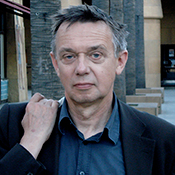Parabeton - Pier Luigi Nervi and Roman Concrete
 트레일러 재생
트레일러 재생
Heinz EMIGHOLZ
- Germany
- 2012
- 103min
- 12 +
- DCP
- color
Asian Premiere
Synopsis
Parabeton – Pier Luigi Nervi and Roman Concrete begins with the earliest surviving concrete dome from the 1st century BC in Baiae, near Naples. It then presents 17 buildings by Pier Luigi Nervi (1891-1979), a master of concrete architecture. Featured structures include the Pirelli skyscraper in Milan, UNESCO Headquarters in Paris, Palazzo del Lavoro in Turin, Palazzo dello Sport in Rome, and the Papal Audience Hall in Vatican City. The film intermittently examines significant Roman buildings like the Pantheon, Baths of Caracalla, and Hadrian's Villa, linking Nervi’s innovative work with ancient Roman concrete architecture.
Review
Parabeton – Pier Luigi Nervi and Roman Concrete celebrates the legacy of Italian architect Pier Luigi Nervi, one of the 20th century's most innovative architectural engineers and artists. Renowned for his groundbreaking use of concrete in creating diverse geometric patterns, Nervi's genius is explored through 17 of his most notable works, including the UNESCO headquarters in Paris, Rome's Olympic Stadium, and the Papal Audience Hall in Vatican City. In this concluding installment of the "Architecture as Autobiography" series, director Heinz Emigholz broadens his scope, tracing Nervi's architectural inspirations back to ancient times. This approach is particularly fitting in Rome, a city where ancient and modern structures harmoniously coexist. Emigholz's lens captures the remarkable durability of concrete structures in iconic ancient buildings like the Pantheon and the Baths of Caracalla, which have endured for millennia and continue to shape Rome's urban landscape. The film's distinctive style, featuring shots that rarely include human presence aside from ambient sound, creates a unique dialogue between past and future. By juxtaposing spaces from both ancient and modern eras united by the medium of concrete, Parabeton – Pier Luigi Nervi and Roman Concrete offers a profound meditation on architectural evolution. More than just a documentation of Nervi's work, this film serves as an exploration of an architect's enduring influence, a reflection on the material that has supported human civilization for centuries, and a majestic tribute to the history and environment of Rome itself.
Director
-

Heinz EMIGHOLZ
Heinz Emmichholz explores the boundaries between art and film through a variety of mediums, including film and drawing. His early works are experimental from the perspective of architecture, and he was described by Variety as “architecture's most accurate observer”. His films document the origins, fate, history, and demise of architectural modernism.
Credit
- ProducerFrieder SCHLAICH, Irene VON ALBERTI
- Screenwriter Heinz EMIGHOLZ
- Cinematography Heinz EMIGHOLZ
- Editor Heinz EMIGHOLZ, Till BECKMANN
- Sound Christian OBERMAIER, Stefan KONKEN




